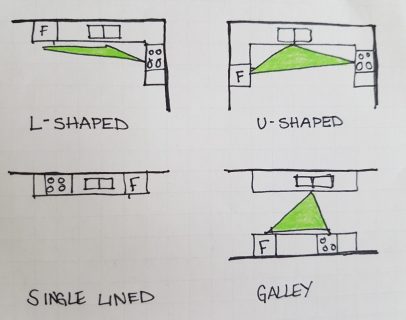Before you start picking cabinet styles and colours there are a few basics that need to be addressed.
A kitchen layout
There are two design philosophies: The work triangle and work zones.
When kitchens were smaller, compact and a few dozen less small appliances, the work triangle made the space more ergonomic. With everything with a comfortable reach. The kitchen work triangle is an imaginary line drawn between three most used points in a kitchen which are the refrigerator, cooker/stove and the sink without any obstructions (i.e. table or an island). The ideal distance between points should not exceed 9′-0″.
As kitchens and appliances become larger, tasks are usually grouped or zoned. Cooking, washing and storage are the most used but it could expand to include prep, baking, and entertaining to suit your lifestyle. When planning your kitchen, think about how you will use it. For an example, you would want to avoid walking with a boiling pot of water across the kitchen to drain your pasta at the sink. So you place the sink close to the cooker or you could add an additional prep sink if your kitchen is large enough.
But as with most things, striking a healthy balance between both the work triangle and the work zones that suits your needs is the best solution
Shape
There are many layouts for a kitchen: Single line (with or without an island), Galley, L-shaped, U-shaped are among the popular configurations. Fundamentally, your layout is influenced by the size and shape of your room as well as the functions that you which to incorporate.
Size (or over size) of appliances and Balance
Group larger appliances to allow for a free flowing counter space. Having larger appliances dotted around the kitchen can create smaller and sometimes unusable spaces.
Add-ons and separate areas
The kitchen is also influenced by its support spaces and adjacent spaces. Thinking how they interact and potentially “free-up” some area within your new kitchen. Placing over-flow storage elsewhere in a separate pantry or adding niche spaces for bar seating.
- island
- peninsula
- work/office space
- wet/dry bar, storage
- eat-in kitchen
- utility room
- pantry
- butlers pantry
- outside access to garden/patio
- access to dining
- sight lines to living spaces
Planning for your small appliances
One may say that “it will be fine…it’ll sort itself out” but keeping note of what you use most and when you use it, could make the morning rush a little less stressful. Grouping the coffee maker and toaster away from where you are prepping lunch boxes could relieve kitchen congestion.
Allow adequate space and height for the things you use most. If you make smoothies every day perhaps allow it to have a permanent spot. Whereas storing that stand mixer in a pantry for the occasional use will free up some counter space for your everyday activities.
Conclusion
With the basics covered, you should start to know what layout and shape suits your needs and the existing space. Figuring out your work triangle and zones informs you where you should place your appliances. The sight lines to other rooms and adjoining utilities refine your choices. Where your appliances are should dictate where you store things ( pots, pans, spices, dish towels etc). Knowing what small appliances you use on a regular basis enables you to create activity spots to enhance the flow of the kitchen ( ie cereal dispenser or coffee bar)
Now you are well on your way to pick colours and cabinets. Have fun!







